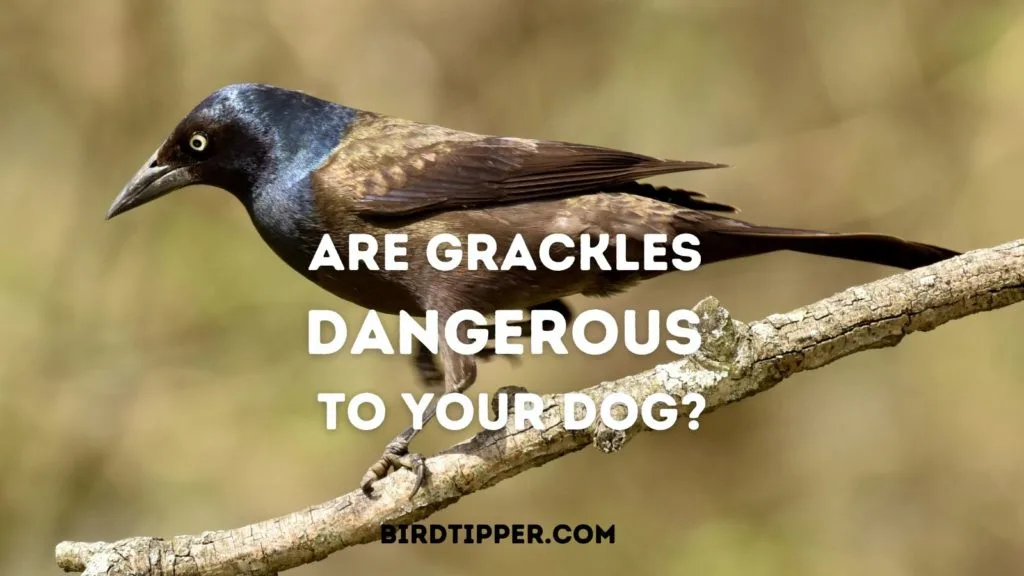We love attracting various birds to our feeders but one we don’t have–probably because we do live in the country–is the grackle. These large blackbirds like to congregate (if you’ve ever parked in a tree-lined parking lot, you know what I mean!) If you share your home with a dog, do you ever wonder if feeding birds–grackles and others–can be dangerous to your dog?
Below we have a guest post from the Texas A&M College of Veterinary Medicine & Biomedical Sciences about this very topic. If grackles are visiting in a flock–with that bird poop they leave behind, could those droppings could present a risk to your dog?

Should I Be Worried About My Dog Around Grackles?
We’ve all seen and heard them—lurking in well-lit, open areas, swooping down from trees, lining up on power lines, and pecking at food left on the ground.
Great-tailed grackles are notorious for congregating in our most frequented parking lots and city parks, but have you ever considered the diseases these pesky birds may carry?
Dr. Sarah Hamer, director of the Schubot Exotic Bird Health Center and an associate professor at the Texas A&M College of Veterinary Medicine & Biomedical Sciences, has focused her studies on just that.
“This species has expanded in geographic range and thrives in urban environments, where it breeds and communally roosts,” Hamer said. “With such a large number of birds in close proximity, we have been interested in the disease-causing organisms that might be transmitted among the birds and potentially to people and other animals.”
To test for these pathogens, Hamer and her team, including students enrolled in a field research course, trapped birds in parking lots around town and collected blood and fecal samples from them.
Although our pets typically do not hang out in parking lots where grackles roost, there is a chance for fecal exposure when walking your dog on well-lit sidewalks, around city parks, or in other areas where grackles hang out. To avoid exposure and contamination, it is imperative that owners keep their pets away from any disease-carrying bird and its feces.
“We tested the feces of the grackles for Salmonella, a bacterium that lives in the gut of animals and can be excreted,” she said. “Fecal contamination can lead to transmission of the Salmonella to other animals or humans. We found that a small percentage of the birds, 2 of 114 birds, or 1.8 percent, were shedding Salmonella in the feces.”
We also examined the blood of the grackle under microscopes using molecular and immunology methods for parasites. According to Hamer, the grackles they have studied were found to be infected with tiny microscopic roundworms, protozoan parasites related to malaria, and West Nile virus. Some of these parasites are zoonotic, meaning they can spread to humans, whereas others only infect birds.
“Avoiding avian feces, or any wildlife feces, is good practice in general,” Hamer said. “If shopping carts are in parking lots with grackle roosts, washing the handles with a hand sanitizing wipe would also be wise.”
Like many other wild animals, they can be infected with pathogens that are detrimental to our health and the health of our furry friends; however, avoiding direct contact with the birds and their feces can minimize risk.
So there you have it. If grackle or other bird droppings are becoming a problem beneath your feeder, an easy fix–at least for a while–is a layer of mulch. (Don’t buy cocoa mulch; it is toxic to dogs, however!) Mulch will cover over the droppings as well as seed hulls, leaving your feeder area cleaner and more attractive.
- Can Grackles Be Dangerous to Your Dog? - October 13, 2022
- Can Hummingbirds Predict Hurricanes? - October 1, 2022
- How to Make Eggshell Calcium for Birds - September 25, 2022
